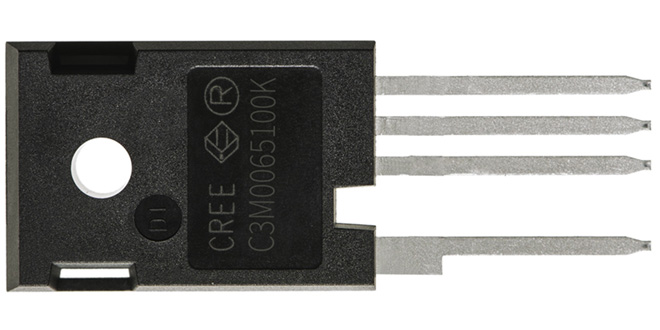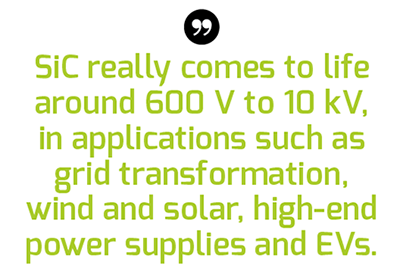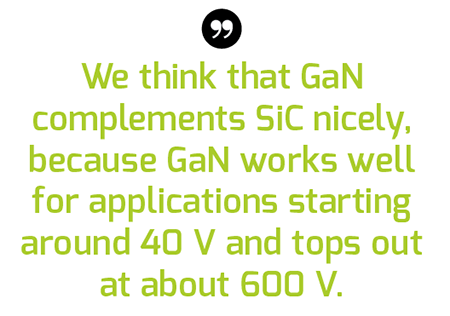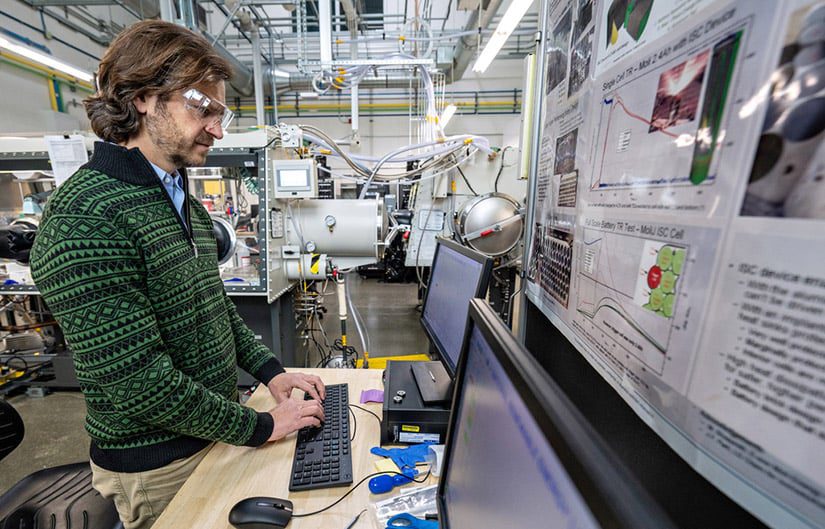Wide Bandgap (WBG) semiconductor technologies have attracted a lot of attention and research funding in the past decade. Both public and private institutions around the world have been obsessed with accelerating the evolution of WBG tech into commercial power electronics applications.
What’s all the fuss about? WBG materials such as silicon carbide (SiC) and gallium nitride (GaN) can greatly improve power conversion efficiency.
A bandgap is the energy needed to excite electrons from a material’s valence band into the conduction band, and WBG materials have bandgaps significantly greater than that of silicon. Silicon (Si) has a bandgap of 1.1 eV (electronVolt); silicon carbide (SiC) has a bandgap of 3.3 eV, and gallium nitride (GaN) has a bandgap of 3.4 eV.
The wider bandgaps allow WBG materials to withstand far higher voltages and temperatures than silicon. This means they can operate with greater durability and reliability at higher voltages and frequencies, which in turn allows them to achieve higher performance while using less energy.
According to the US DOE, WBG semiconductors can theoretically eliminate up to 90% of the power losses that currently occur during power transfer, and they can handle voltages more than 10 times higher than silicon-based devices.
Applied in an EV, the math is relatively simple. Increasing the efficient use of energy allows you to reduce the high costs of battery packs, shorten charging times or improve driving range.

In January, Wolfspeed – a division of Cree – introduced a new SiC MOSFET specifically designed for EV drivetrains.
Charged chatted with Wolfspeed’s senior director of power products Guy Moxey to learn more.
Charged: Where are you seeing the most near term commercial opportunity for SiC growth, and where does it fit best?
Guy Moxey: Cree is a pioneer of SiC wafer technology, primarily used for high power LEDs. Wolfspeed is the division of Cree that specializes in SiC discrete devices and modules for RF and power products. The power market for SiC is relatively new – it’s really in the last eight years that products have become commercially viable – but we see it growing quickly because of what the technology can enable.
SiC does basically the same thing as silicon, it just does it far more efficiently. And the world has been asking for more efficient power conversion for a long time. We see the market for it growing through legislation, through consumer demand and through the pure cost of energy.
Generally speaking, SiC is best suited for the higher-voltage side of life. You’re not going to find a SiC power semiconductor in a cell phone that operates at about 4 V max. The power and the voltage requirements are very small in these ultra-portable applications, and silicon works fine. Silicon has been around for 60 years – it does a great job and is pretty cost-effective for low-voltage systems.

SiC really comes to life around 600 V to 10 kV, in applications such as grid transformation, wind and solar, high-end power supplies and EVs.
For the short and mid-term, SiC will be more expensive than silicon – even at scale – due to raw material costs. However, for many power applications, the efficiency increases that SiC enables will unlock greater cost savings throughout the system. You’re not simply unplugging a silicon switch and plugging in a SiC switch.
The trick is to redesign the circuit around the SiC. Then, for example, you can reduce the number of switches, increase the switching frequency and reduce the size and cost of all the magnetics. In other words, SiC allows you to increase the overall design efficiency and reduce the bill of materials.
Also when you think about transportation and EVs, form factor, size, weight, and cooling are all significant factors to consider. If you increase system efficiency with SiC, you can reduce all of those.
Charged: Are there production vehicles on the road today that contain SiC power products?
GM: Yes. There are EVs from many different manufacturers on the road that contain Wolfspeed’s SiC power products. In the last 3 or 4 years, we’ve built up our business base by winning a lot of designs for on-board charging and DC-to-DC power conversion systems for EVs. The SiC-based systems allow for higher switching frequency and lower losses. Among other advantages, SiC allows you to reduce the size and form factor of the system, which is a huge benefit for a car.

So we’ve won a lot of that business, which has given us great validation, proving the pedigree of Wolfspeed SiC in automotive. In the auto industry, the testing is rigorous but the ultimate validation is the hours of operation in the field. Your quality and reliability has to be top-class.
Now we’re starting to also focus on the EV’s powertrain, with the launch of our first products targeted at the motor inverter.
Charged: How do your products for inverters differ from those used for chargers and DC-to-DC converters?
GM: The charger is a similar voltage but it’s a lot lower power rating. Typically an on-board charger is about 3 to 6 kW total, and to drive a motor you’re looking at hundreds of kW. They operate differently as well. With a DC-to-DC converter, for example, you want to operate at as high a frequency as practical, because the higher the frequency, the smaller the magnetics – which reduces system cost and weight. In DC-to-DC conversion, Silicon is limited to a few hundred kHz in switching frequency, otherwise it gets too hot and inefficient, whereas with SiC, we can do a few times that frequency without any sacrifices in efficiency.
The SiC devices used in on-board chargers are smaller, lighter and faster than the devices we have developed that target the motor drive. The inverter wants heavy current and relatively low switching frequency. So, we developed the highest current rated SiC device available – a 900 V, 10 mΩ MOSFET rated for 196 A of continuous drain current.
Charged: Traditional motor/inverter systems using silicon switches are very efficient. What gains can SiC offer?
GM: When you look at an EV, the inverter drive losses are about 7% of the total car loss. So yes, the inverter and motor system is pretty efficient compared to things like the gearbox and bearings. But when the car is battery-operated, it’s very important to get every drop of efficiency you possibly can. What may seem like small increases in efficiency actually translate into noticeable increases in your EV range and time between charges.

We have found that using our new SiC 900 V, 10 mΩ MOSFET can reduce inverter loss by as much as 78%. So the energy lost in the motor drive goes from about 7% of the total car loss to about 2%. So, by designing your inverter with SiC, you can then reduce the size of the battery pack while achieving the same range, or increase the range for a given battery pack.
The 900 V power module that we recently showcased has a remarkably low 2.5 mΩ on resistance (Rds(on)) – which is a built-in parameter of the transistor that represents the internal resistance when it is in its fully conducting state. You want the smallest Rds(on) as possible, because it’s directly related to the loss.
Charged: What are the biggest design challenges you faced while designing the SiC device for inverters?
GM: Packaging is one of the challenges with high-current SiC chips. If you take the typical module and simply swap out the legacy silicon chips with a SiC chip, you can’t operate as fast as you want to because it’s handcuffed by silicon packaging. Silicon switches slowly, so those modules can be pretty clunky, with a lot of inductance. Whereas if you’re going to increase the switching frequency three, four, or five times, you’d have to cleverly design the layout and the interconnectivity of these modules to reduce the stray inductance. We need to really streamline things to minimize inductance and utilize the potential of the SiC by redesigning components like the wire bonds and the parts that you connect or solder. Also, the thermal performance of SiC is much different, so the thermal management components need to be redesigned as well.
Basically, when you put SiC into silicon packaging, it’s like taking an engine from a Lamborghini and putting it into an economy four-door sedan. So we are continually working to develop advanced packaging that can really cope with the potential of the SiC chip inside.
Our new module (CAS325M12HM2) is really the first commercially released module in the world that is designed specifically for SiC.
Charged: How many different iterations or generations of SiC power products have you commercially released?
GM: Our latest and greatest MOSFET power portfolio – including our new SiC 900 V, 10mΩ MOSFET – is part of our third generation of products, which launched about a year ago. We proliferated out with some variations of the products that are getting designed into new generations of on-board chargers.
We’ve also had a lot of success with off-board charging stations, particularly in Asia, where we see a huge push to fast charging stations.
Charged: GaN is another WBG technology that we hear a lot about. Do you think that GaN has potential applications in EVs?
GM: We actually produce more GaN than anyone else in the world. However, we use it for RF power purposes. We think it’s best for low-voltage, ultra-high switching frequencies – the MHz and GHz range. That is where RF comes in, which is the other side of our Wolfspeed division. There are some companies working on GaN on silicon for use in power conversion, however it is a very new technology approach.

We think that GaN complements SiC nicely, because GaN works well for applications starting around 40 V and tops out at about 600 V. So that makes GaN a potentially disruptive technology for portable applications like computers, cell phones and tablets. According to GaN experts working in that area, it can be more cost-effective a device than silicon. So if it can perform better and this price is better, it stands a fairly good chance once it’s proven itself as a technology.
But for an application like an EV powertrain inverter, we don’t think it’s a great fit. Because of the way the technology is built, you need very big chips to get high current, and that means higher costs and larger packages.
Charged: How soon could there be production EVs on the road with SiC-based inverters?
GM: We’ve only recently had the right chips that are powerful enough to satisfy the needs of the powertrain. The automotive industry has really long design cycles and rigorous testing, so it’s difficult to predict. We’ve done all the R&D and produced a commercial product, so now it’s a matter of continuing our work with the EV engineers and winning designs. We know that the current rating of our new chips gives designers what they’ve been waiting for in SiC technology.
This article originally appeared in Charged Issue 29 – January/February 2017 – Subscribe now.


















































































